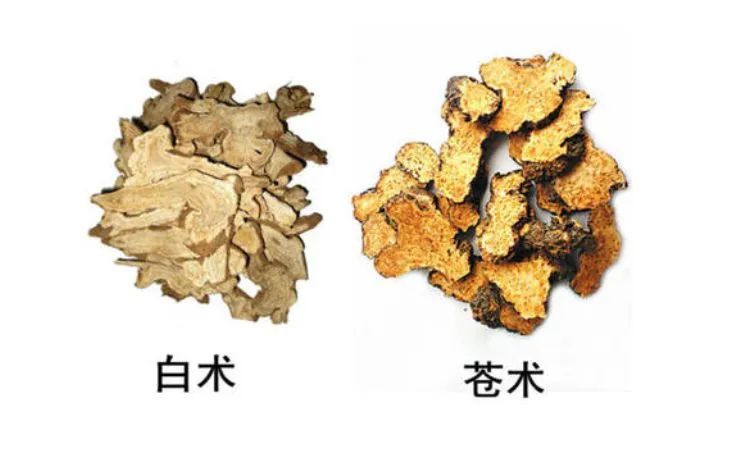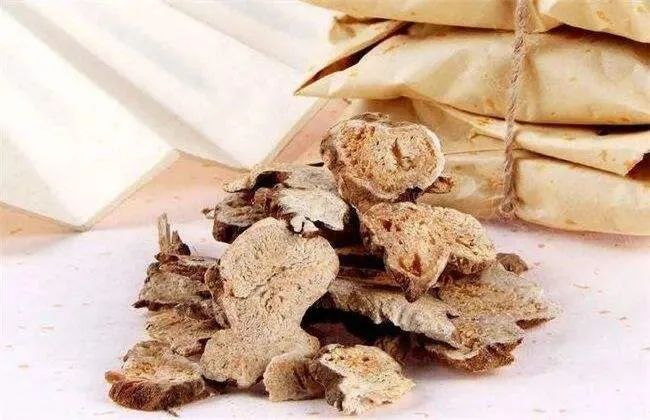Comparative Use of Cang Zhu and Bai Zhu
Cang Zhu and Bai Zhu were not distinguished in ancient times. The Shen Nong Ben Cao Jing only mentions “Zhu” without differentiating between Cang and Bai. During the Wei, Jin, and Northern and Southern Dynasties, Tao Hongjing classified “Zhu” into Bai and Chi types based on their morphology, properties, and uses, but their functions were still not differentiated and were collectively referred to as Zhu. Later, in the Song Dynasty, Kou Zongshi’s Ben Cao Yan Yi clearly distinguished between Cang Zhu and Bai Zhu.
When I was in school, Professor Ling Yiqui mentioned that Cang Zhu has a strong pungent and bitter warm nature, with a strong effect of inducing sweating and harming Yin, which left a significant impression on me, making me hesitant to use it recklessly. Therefore, over the years, I have used Bai Zhu more frequently, while Cang Zhu has been used relatively less, mainly due to concerns about its potential to harm Yin and deplete fluids. Later, I observed Professor Dai Yuguang (a graduate of Beijing University of Chinese Medicine, class of ’62, currently at the Third Military Medical University) skillfully using Cang Zhu for patients with ascites due to liver cirrhosis, and he did not hesitate to use it for some patients with red tongues and Yin deficiency, only slightly adjusting the formula. The renowned Chengdu TCM practitioner Wang Jing’an, known as “Wang Xiaoer,” in his Wang Jing’an Clinical Essentials, frequently used Cang Zhu for pediatric diarrhea and anorexia, rarely using Bai Zhu, stating that “Cang Zhu has an aromatic flavor and is not harshly drying, and contains nutritional components, so I often prefer to use it clinically.” This is not an empty claim.
The Shen Nong Ben Cao Jing states: “Zhu is bitter and warm, primarily treating wind, cold, damp obstruction, dead flesh, jaundice, stopping sweating, eliminating heat, digesting food, and when cooked into a porridge, long-term use can lighten the body and prolong life without hunger.” This mainly refers to the functions of Bai Zhu. Influenced by the Ben Jing, Bai Zhu has been more frequently respected and used in clinical practice over the years, and it has been used as a tonic, which has somewhat affected the correct application of Cang Zhu.
How should we grasp the use of Cang Zhu and Bai Zhu?
Cang Zhu and Bai Zhu both have the functions of drying dampness and strengthening the spleen. As long as we grasp the functional characteristics of both, they can be effectively used in clinical practice.

Cang Zhu
First, let’s discuss the characteristics of Cang Zhu. Starting with its applications:
① Cang Zhu has a strong pungent and warm nature, making it effective for inducing sweating and dispelling dampness, thus it should be the first choice for conditions with little sweating.
② Cang Zhu is bitter and drying, effective at drying damp turbidity, suitable for conditions of cold dampness, dampness that has not transformed into heat, and dampness without heat, such as a thick white and greasy tongue coating and a pale or non-red tongue, or for those who do not find food flavorful, Cang Zhu should be selected.
③ For conditions where damp turbidity is widespread throughout the body, only Cang Zhu should be selected, as Bai Zhu’s ability to eliminate dampness is weak and not suitable. Cang Zhu’s strong pungent and warm drying properties are appropriate for dispelling dampness. As stated in Yao Pin Hua Yi: “To govern dampness in the three regions: if in the upper jiao, it easily produces damp phlegm, thus it dries dampness and moves phlegm; if dampness is in the middle jiao, it causes stagnation leading to diarrhea, thus it regulates the middle and strengthens the spleen; if dampness is in the lower jiao, it causes weakness in the legs and knees, thus it can be used with Huang Bai to treat weakness, enabling strength in the legs and knees.”
④ Cang Zhu is effective at resolving the toxic gases of damp turbidity, for any foul and turbid evil qi, or epidemic damp toxins, Cang Zhu can be soaked in well water or burned in the courtyard, with the smoke achieving the desired effect.
⑤ Cang Zhu excels at relieving depression, “especially able to directly enter the meridians, dispelling the dampness of Yangming, thus it is effective for various forms of depression” (from Chi Shui Xuan Zhu). It is often paired with Chuan Xiong for even better results. Dan Xi Xin Fa states: “Cang Zhu and Chuan Xiong together relieve all forms of depression… all depression is in the middle jiao, using Cang Zhu and Chuan Xiong to open and elevate its qi.”
Precautions:
① Those with excessive sweating should not use it alone, or it can be used with Bai Zhu to ensure safety.
② Those without obvious damp turbidity should not use it.
③ For those with Yin deficiency and internal heat, with a red tongue and little or no coating, caution is advised, and it can be paired with Yin-nourishing but not greasy herbs like Shi Hu (Dendrobium) and Bai He (Lily Bulb) to mitigate its drying nature.
④ For those with a tendency to bleed, such as epistaxis, hemoptysis, or hematemesis, even with damp turbidity mixed in, the dosage should be light.

Bai Zhu
Next, let’s discuss the characteristics of Bai Zhu. Suitable uses:
① Bai Zhu is primarily known for its tonifying properties, thus it should be the first choice for strengthening the spleen and benefiting qi, as it eliminates dampness without being drying, or if it is drying, it is not harsh. It achieves this by strengthening the spleen to transform water and dampness, allowing Bai Zhu to be used without concern for its drying harming Yin, and it can also moisten the spleen and generate fluids. In other words, Bai Zhu generates fluids through tonifying qi. Ben Cao Quan Bian explains: “The spleen dislikes dampness; if dampness prevails, qi cannot transform, and how can fluids be generated? Therefore, it is said that the bladder is the reservoir of fluids, and when qi transforms, it can be released. Using Bai Zhu to eliminate dampness allows qi to circulate and fluids to be generated.”
② Bai Zhu excels at stopping sweating, as seen in Yu Ping Feng San. For issues of sweating, Bai Zhu is comprehensive, effective at stopping sweating, and does not hesitate even in the absence of sweating, which is distinctly different from Cang Zhu.
③ Bai Zhu is beneficial for stabilizing pregnancy, primarily because Bai Zhu tonifies spleen qi and can also consider the blood aspect, especially the larger winter Bai Zhu is better. As Zou Run’an states in Ben Jing Shu Zheng: “Zhu is a medicine for the middle jiao; if it has a greasy liquid and is red, it is a medicine that tonifies the qi while eliminating dampness, and it indeed has effects on the blood aspect.” Therefore, it is a superior choice for stabilizing pregnancy in early stages.
④ Bai Zhu can also beautify the complexion, which is one of its characteristics. Yao Xing Ben Cao states: “It primarily brightens the face, enhances beauty, and removes blemishes. Clinically, it is effective when paired with roasted Tu Si Zi (Dodder Seed) for treating facial pigmentation in women.
Precautions:
As stated in De Pei Ben Cao: “Chest and abdominal rumbling, liver and kidney qi movement, anger harming the liver, spleen Yin deficiency, ulcers, running piglet syndrome, asthma, thirst, and when boils have formed pus, these nine conditions should be avoided.” The use of the term “avoid” here is too absolute; it can still be used in combinations.
Among the mentioned “chest and abdominal rumbling,” I have observed in clinical practice that Bai Zhu has a significant effect on promoting gastrointestinal peristalsis, especially raw Bai Zhu, which is even more pronounced. For treating constipation with raw Bai Zhu, a large dose can lead to rumbling in the intestines and frequent flatulence, resembling hunger. Sometimes, to strengthen the spleen and benefit qi for treating loose stools, I have used Shen Ling Bai Zhu San, where an excessive dose of Bai Zhu or using raw Bai Zhu instead of the properly processed one has often resulted in patients experiencing continuous diarrhea after taking it.
Regarding Bai Zhu’s long-term use for weight loss, longevity, and its effectiveness in treating lower back pain, these are all recorded in ancient medical cases. I believe this refers to wild Bai Zhu; modern Bai Zhu is mostly cultivated, which may not have the same longevity effects. As stated in Ben Cao Fen Jing: “Wild Zhu can replace true ginseng, but true wild Zhu is extremely difficult to obtain. Cultivated Bai Zhu strengthens the spleen and dries dampness, and can only regulate common spleen and stomach diseases.”
 Conclusion
Conclusion
Bai Zhu is sweet and bitter, warm; Cang Zhu is pungent and bitter, warm. Traditional Chinese Medicine believes that bitterness can dry, and warmth can dry, thus both Bai Zhu and Cang Zhu can strengthen the spleen and dry dampness, treating conditions of spleen dysfunction and damp turbidity obstruction. However, Bai Zhu’s function leans towards tonifying qi and strengthening the spleen, suitable for those with spleen deficiency and damp obstruction; Cang Zhu has a strong bitter and warm drying effect, suitable for cold damp obstruction in the middle jiao where spleen deficiency is not obvious.
In addition, Bai Zhu can also stabilize the exterior and stop sweating, promote urination and reduce swelling, benefit qi and stabilize pregnancy, treating conditions of qi deficiency with spontaneous sweating, spleen deficiency with edema, phlegm-dampness, and restless fetus; Cang Zhu can also dispel wind-dampness, induce sweating and release the exterior, brighten the eyes, and treat wind-damp obstruction pain, exterior conditions of wind-cold with dampness, and night blindness.
Bai Zhu is biased towards strengthening the spleen, thus it is often used for spleen and stomach qi deficiency. Cang Zhu, with its greater drying nature, is more often used to treat dampness obstructing spleen yang or heavy dampness causing “bi syndrome.”
Source: Excerpted from Old Physician’s True Words, published by China Traditional Chinese Medicine Press, Author: Wang Huiwu. All rights reserved.


